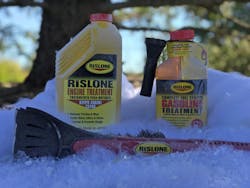Tech Tip: Cold weather idling can harm modern engines
Contrary to conventional wisdom, idling does surprisingly little to warm the engines of today’s gasoline-powered vehicles. Modern engines are engineered so they’ll actually warm up faster if they are driven, not left to idle for long periods of time. Until the engine warms up sufficiently, the onboard computer system is putting extra gas into the combustion chamber. And all that gas is an outstanding solvent that can wash lubricating oil off the walls, causing significant extra wear and friction on components like piston rings and cylinder liners. This engine warming ill effect can be fought off with engine treatment products like Rislone Engine Treatment.
In a cold engine, gasoline is less likely to evaporate and create the correct ratio of air and vaporized fuel for combustion. Computer sensors in the electronic fuel injection system compensate for the cold by pumping more fuel into the mixture, running rich in this way until it heats the engine up enough to switch back to a normal fuel-to-air ratio. For most winter drivers, the fastest way to warm up the engine is to start the car, take a minute to knock the ice off the windows, and then drive off nice and easy. Then give the engine about 5 to 15 minutes to totally warm up, running on a normal gasoline-to-air ratio.
But many of your customers still want to start their vehicles – perhaps with the aid of a remote start system – and enjoy a hot cup of coffee indoors, while their vehicle engines idle until the car interior is nice and toasty. We get that. For those customers, you can offer easy low-cost protection against the extra wear and friction caused by long idling.
First, an engine treatment will add lubrication to the engine to reduce cold startup idling friction and wear. A fuel system treatment will lubricate upper cylinders and liners subject to cold startup idling wear. This combination of products isn’t a high-maintenance plan. Simply use the engine treatment at every oil change, and use the fuel system treatment every 5,000 miles for best results. Affordable, easy and guaranteed to make it easier on your customer’s car on those cold winter mornings when they let it idle for many minutes to warm up.
Warming up a car before driving is a leftover practice from when carbureted engines dominated the roads 30 years ago. Because carburetors didn’t have sensors to tweak the mix of gasoline and air, you had to let older cars warm up before driving or they could stall. Nowadays, long winter idling warm-ups may provide a toasty passenger compartment, but since idling uses a richer level of gas, it’s bad for modern engines.
Information provided by: Rislone
